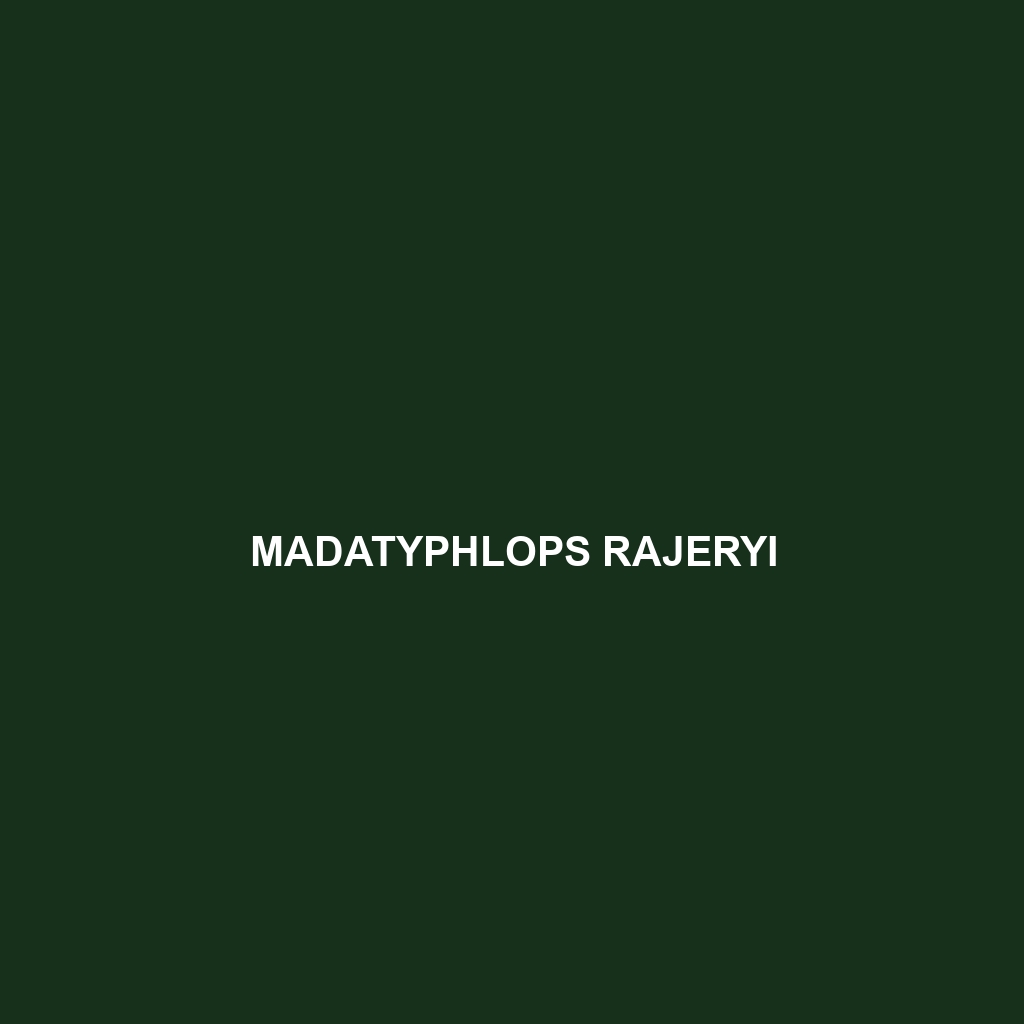Common Name
Madatyphlops rajeryi
Scientific Name
Madatyphlops rajeryi
Habitat
The Madatyphlops rajeryi, commonly known as the Rajery’s blind snake, is primarily found in the lush, verdant rainforests and temperate forests of Madagascar. These specific environments are characterized by high humidity, rich biodiversity, and a diverse array of plant life, providing an ideal habitat for this unique species. Madagascar, recognized as a biodiversity hotspot, offers an array of niches from lowland rainforest to montane ecosystems. The warm climate, coupled with abundant leaf litter and underground moisture, supports the lifecycles of Madatyphlops rajeryi, allowing it to thrive in these secluded terrestrial zones.
Physical Characteristics
Madatyphlops rajeryi displays several distinctive physical characteristics. Adults typically reach lengths of about 25 to 30 centimeters (10 to 12 inches). Their elongated, cylindrical bodies are covered with smooth, shiny scales that can vary in color from light brown to dark reddish-brown, often featuring subtle patterns that provide excellent camouflage among soil and leaf litter. A crucial adaptation for their subterranean lifestyle is their reduced, vestigial eyes, which are only visible as small dots, emphasizing their blind nature. This evolution allows them to navigate seamlessly through their dark, underground habitats, making them highly specialized burrowers.
Behavior
Madatyphlops rajeryi is predominantly a nocturnal species, engaging in most of its activity during the cooler hours of the night. This behavior helps them avoid the heat of the day, as these snakes often spend their time underground or hidden within debris. Their social interactions are generally solitary, but they may be observed in pairs during the mating season. One notable behavior is their unique burrowing method; they utilize their specialized snouts to excavate soil, allowing for efficient movement and foraging. When threatened, they may exhibit a rare defensive behavior by coiling tightly and remaining motionless, relying on their cryptic coloration for camouflage.
Diet
The diet of Madatyphlops rajeryi primarily consists of small invertebrates, making them insectivores. They primarily feed on earthworms, termites, and various soil-dwelling insects that they encounter while foraging. Their dietary habits reflect a specialized adaptation to their habitat, as they rely on the abundant insect population present in the leaf litter and soil. This feeding behavior also plays a role in maintaining the ecological balance within their forest environments, contributing to soil aeration and pest control.
Reproduction
Reproduction in Madatyphlops rajeryi follows a seasonal pattern, with mating typically observed during the warmer months when environmental conditions are optimal. The gestation period lasts approximately three to four weeks, after which the female gives birth to live young. However, exact numbers can vary, with females typically giving birth to around 3 to 10 offspring at a time. There is limited parental care, as the young are immediately independent upon birth. These offspring resemble miniature adults, possessing the same characteristics but in a smaller form, quickly adapting to their environment.
Conservation Status
Currently, Madatyphlops rajeryi is classified as ‘vulnerable’ by the IUCN Red List. Habitat destruction due to deforestation, agricultural expansion, and urban development poses significant threats to their population. Conservation efforts are underway, focusing on habitat preservation and the implementation of protected areas to safeguard the remaining rainforest ecosystems of Madagascar. Collaborative actions involving local communities are essential to raising awareness and promoting sustainable practices that protect these unique species.
Interesting Facts
One remarkable characteristic of Madatyphlops rajeryi is its adaptation to a burrowing lifestyle—it possesses a unique lack of external limbs, with its body modified for a smooth, streamlined shape that facilitates movement through soil. Additionally, despite their status as blind snakes, these creatures utilize other senses, such as smell and touch, to navigate their environment. Their discovery in 2000 highlighted the biodiversity of Madagascar and the ongoing need for research into this relatively under-studied group of snakes.
Role in Ecosystem
The ecological role of Madatyphlops rajeryi is significant, as they contribute to the soil health of their habitats by preying on invertebrates and recycling nutrients through their feeding habits. As a predator of small soil organisms, their presence helps regulate insect populations, which is crucial for maintaining the balance of the ecosystem. Furthermore, their burrowing activities aerate the soil, promoting the growth of plant life and enhancing the overall health of the forest environment they inhabit. This relationship underscores the importance of preserving not only the species itself but also the intricate ecosystems depending on it.
